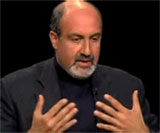 Writing for the Financial Times, Nassim Taleb and Mark Spitznagel remain of the view that there’s too much debt in the world, and that the only reasonable solution to resolve it, is by converting debt-to-equity. This solution hasn’t been seriously considered yet. But, the theory (considering the debt levels we find ourselves in), if applied, could prove beneficial since debt conversions are only debt management strategies designed to reduce external debt while encouraging foreign capital inflow.
Writing for the Financial Times, Nassim Taleb and Mark Spitznagel remain of the view that there’s too much debt in the world, and that the only reasonable solution to resolve it, is by converting debt-to-equity. This solution hasn’t been seriously considered yet. But, the theory (considering the debt levels we find ourselves in), if applied, could prove beneficial since debt conversions are only debt management strategies designed to reduce external debt while encouraging foreign capital inflow.
We believe that stimulus packages, in all their forms, make the same mistakes that got us here. They will lead to extreme overshooting or extreme undershooting. They lead to more borrowing, by socialising private debt. But running a government deficit is dangerous, as it is vulnerable to errors in projections of economic growth. These errors will be larger in the future, so central bank money creation will lead not to inflation but to hyper-inflation, as the system is set for bigger deviations than ever before.
…
Invoking the pre-internet Great Depression as guidance for current events is irresponsible: errors in fiscal policy will be magnified by this kind of thinking. Monetary policy has always been dangerous. Alan Greenspan, former Federal Reserve chairman, tried playing with the business cycle to iron out bubbles, but it eventually got completely out of control. Bubbles and fads are part of cultural life. We need to do the opposite to what Mr Greenspan did: make the economy’s structure more robust to bubbles.The only solution is to transform debt into equity across all sectors, in an organised and systematic way. Instead of sending hate mail to near-insolvent homeowners, banks should reach out to borrowers and offer lower interest payments in exchange for equity. Instead of debt becoming “binary” – in default or not – it could take smoothly-varying prices and banks would not need to wait for foreclosures to take action. Banks would turn from “hopers”, hiding risks from themselves, into agents more engaged in economic activity. Hidden risks become visible; hopers become doers.
(emphasis added)
Disclaimer: This page contains affiliate links. If you choose to make a purchase after clicking a link, we may receive a commission at no additional cost to you. Thank you for your support!


Leave a Reply